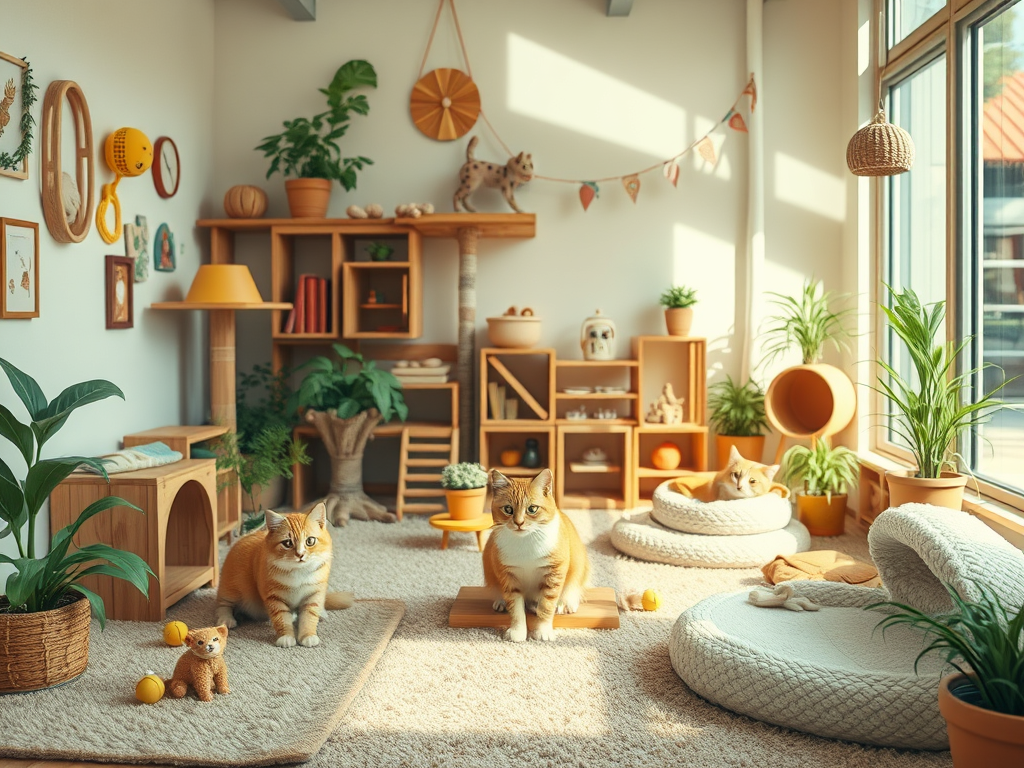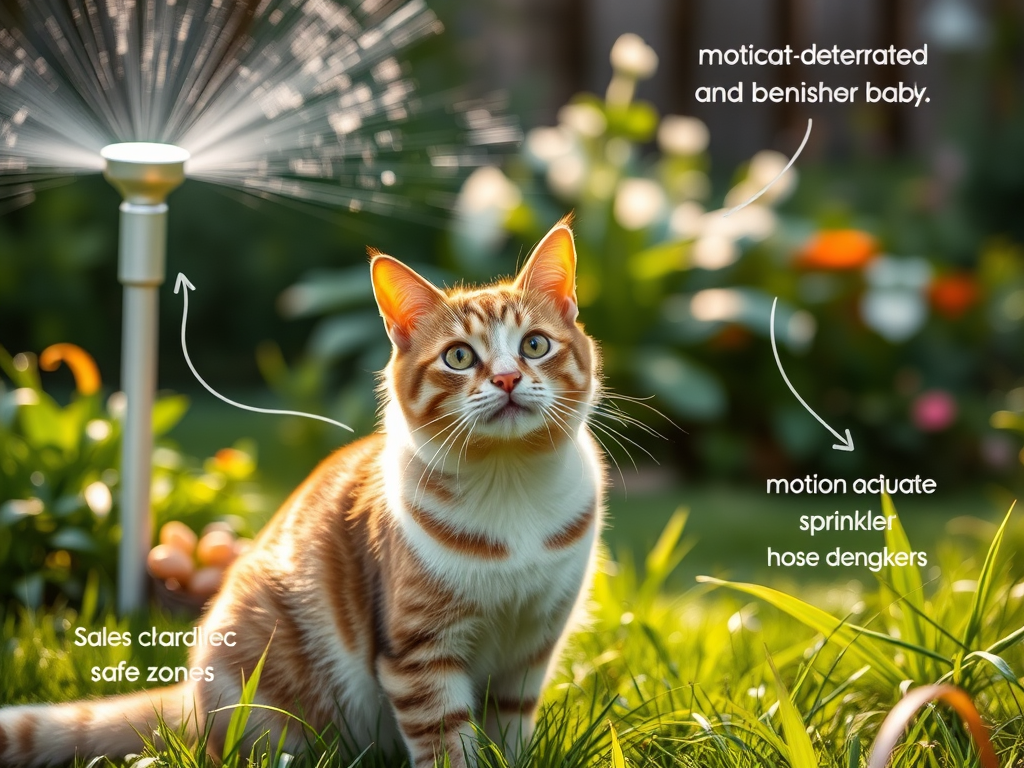Effective Strategies to Reduce Your Cat’s Hunting Behavior
Reducing the Impact of Your Cat's Hunting Instincts: Cats have an inherent hunting instinct that is deeply ingrained in their DNA, stemming from their ancestors. However, as a responsible pet owner, you can create a secure indoor setting that allows your cat to express these instincts while safeguarding local wildlife. By thoughtfully designing stimulating spaces and activities that engage their natural senses and instincts, you can ensure that your feline companion remains active, happy, and fulfilled without endangering unsuspecting animals in the surrounding area.
Incorporating interactive toys into your cat's routine can greatly enhance their indoor hunting experiences. Opt for feather wands, laser pointers, and battery-operated mice that captivate your pet's attention for prolonged periods. These engaging toys simulate the natural behaviors of hunting, allowing your cat to stalk, chase, and pounce, which is crucial for both mental stimulation and physical fitness. By providing these enriching playthings, you not only keep your cat entertained but also support their overall health by helping them channel their energy into constructive play.
Transform your living space into a dynamic playground for your feline friend by constructing obstacle courses filled with boxes, tunnels, and climbing shelves. This creative setup encourages exploration and physical activity, allowing your cat to climb, jump, and investigate various nooks and crannies. Cats are inherently curious and adventurous, and by offering them diverse environments to explore, you can mimic their natural habitat, giving them the thrill of a DIY safari right in your home.
Don’t overlook the significance of puzzle feeders. These ingenious devices not only stimulate your cat's mind but also simulate the effort they would exert while hunting. By integrating treat-dispensing puzzles into your cat's feeding routine, you can keep their cognitive skills sharp while offering a fun and rewarding pastime. This method entertains your pet while promoting healthy eating habits, as they learn to engage with their food and work for their treats.
Prioritize playtime in your home environment. Engaging in social interaction through play is essential for enhancing the bond between you and your cat. Make it a routine to set aside specific times for play sessions, utilizing the same toys they love when playing alone. This shared time not only alleviates any pent-up energy your cat may have but also deepens your connection, making playtime a rewarding experience for both of you.
Creating a stimulating indoor environment for your cat is entirely possible with a bit of creativity and commitment. Your living space can transform from a simple shelter into an adventurous landscape that caters to their hunting instincts while keeping them safe from outdoor dangers. With careful planning and consideration, you can cultivate a happy and fulfilled indoor cat.

Leash Training: Open Up New Opportunities for Your Cat
Embracing leash training can unlock a realm of safe exploration for your feline companion. While walks are typically associated with dogs, cats can also enjoy outdoor adventures with proper training and a patient approach. By introducing your cat to a harness and leash, you can allow them to experience the wonders of nature while ensuring their safety.
Start the leash training journey with a comfortable and snug-fitting harness that suits your cat well. It’s crucial to allow your pet to become accustomed to the harness before attempting to put it on. Allow them to sniff and explore the harness, which will help alleviate any anxiety they may experience. Gradually introducing the harness at their own pace fosters positive associations, making the process smoother and more enjoyable.
Once your cat feels comfortable wearing the harness, attach a lightweight leash and begin practicing indoors. This familiar setting will help them adjust to the feel of the leash while boosting their confidence. Take your time, and expect some initial resistance; patience is essential as you help your cat acclimate to this new experience.
When venturing outside for the first time, select a calm and secure area, such as your backyard or a quiet park. Ensure that the location has minimal distractions and traffic to make your cat feel safe. Start with short outdoor sessions to prevent overwhelming your pet, gradually extending the duration as they become more at ease with their new surroundings.
Supervised outdoor time enriches your cat's life, allowing them to enjoy the sights, sounds, and scents of the outdoors without posing a risk to local wildlife. Imagine the delight on your cat's face as they experience new adventures in a secure environment. This bonding time not only enhances their quality of life but also strengthens your relationship with them.
Real-life stories from other cat owners can serve as great motivation. Many have initially doubted whether their cats would take to leash walking, but with consistency and positive reinforcement, they found success. Celebrate each small triumph as a step toward expanding your cat's horizons while ensuring their safety.
By integrating leash training into your cat's routine, you facilitate a blend of outdoor enjoyment and wildlife conservation. This balanced approach allows your cat to explore their surroundings while fostering a sense of security in their environment.
Creating Secure Outdoor Spaces: Discover the Advantages of Catios
Outdoor cat enclosures, commonly known as catios, offer an ideal solution for adventurous cats yearning for outdoor experiences without the associated risks. These secure spaces enable your feline friends to enjoy the outdoors while ensuring their safety and the protection of local wildlife.
Building or purchasing a catio can be customized to fit your available space and budget. Options range from simple balcony enclosures to more elaborate backyard structures. The primary focus should be on ensuring the enclosure is escape-proof, as safety is paramount for providing a secure environment for your cat.
When designing your catio, consider incorporating multiple levels and cozy hiding spots. Cats flourish in environments that provide vertical spaces and areas to retreat. By adding platforms, ramps, and hammocks, you can transform a basic enclosure into an engaging paradise that mimics their natural habitat.
Enhancing the sensory experience within the catio is also beneficial. Introduce elements like cat grass, scratching posts, or logs to create a stimulating environment filled with various textures and scents. This sensory enrichment can keep your cat engaged and content, allowing them to enjoy the joys of being outdoors in a controlled setting.
Regular maintenance is crucial for ensuring the safety of your catio. Routinely inspect the structure for any signs of wear and tear, including the integrity of the mesh, the overall structure, and the locks. Cats are naturally curious and may test the boundaries of their enclosure, making it vital to keep it in excellent condition for their safety and well-being.
With a catio, your feline friend can engage in sunbathing, climbing, and observing wildlife without posing a threat to local ecosystems. They can bask in sunlight and watch birds from the safety of their outdoor haven, remaining content while wildlife stays protected.

Proven Training Techniques to Curb Your Cat’s Hunting Instincts
Teaching your cat to minimize their hunting behaviors might seem like a daunting challenge, but with the right techniques, it can be a manageable and rewarding task. The first step is to understand their natural instincts and the behaviors that drive them to hunt, which is essential for implementing effective training strategies.
Utilizing technology can significantly bolster your training efforts. Consider employing motion-activated deterrents, such as sprinklers or noise-makers, to establish boundaries that discourage hunting without disrupting other activities. Strategically zoning your yard into safe areas can redirect your cat's attention away from potential prey.
Positive reinforcement plays a crucial role in modifying your cat’s behavior. Reward them for non-hunting actions with treats or affection. For instance, if your cat responds to your call or refrains from pursuing a potential target, offer them a tasty treat or extra affection. This method encourages them to repeat desirable behaviors while reducing their instinctive urge to hunt.
Incorporating clicker training can also be an effective tool for behavior modification. This technique involves associating a distinct sound with positive actions, allowing your cat to make connections between their behavior and rewards. By clicking when they exhibit desirable behavior, you can reinforce good habits and clarify your expectations.
For more personalized support, consider consulting with feline behavior specialists. They can provide tailored advice and insights to address specific challenges, helping you and your cat live together harmoniously while respecting local wildlife.
The goal of deterrents and training is not to punish but to guide your cat toward behaviors that prioritize their safety and the environment. With consistency and patience, you can redirect their instincts, leading to safer outdoor interactions for both your cat and local wildlife.
Nutrition Tips to Help Reduce Your Cat’s Hunting Drives
The type of food you provide and the feeding methods you adopt can profoundly influence your cat's hunting instincts. Interestingly, a well-fed cat may still exhibit hunting behaviors; however, the way you feed them can help mitigate this drive effectively.
Free feeding, where food is accessible throughout the day, may not be suitable for every cat. Instead, consider implementing a structured feeding schedule. By establishing predictable mealtimes, your cat may be less inclined to hunt, as they learn to associate food with specific times of the day, thereby reducing their need to seek out prey.
Interactive feeding strategies can be transformative for your cat's behavior. Utilizing food puzzles or dispensers can replicate the act of hunting, requiring your cat to ‘work' for their meals. This approach not only keeps them mentally and physically stimulated but also channels their energy positively, allowing their natural instincts to manifest in a controlled manner.
Pay attention to the nutritional content of their food as well. A diet high in protein and low in carbohydrates aligns better with a cat's natural dietary needs, which may help decrease hunting behaviors. Collaborating with a veterinarian to customize the diet can ensure your cat's nutritional requirements are effectively met.
Finally, offering a variety of food types can satisfy their inherent curiosity and appetite for novelty. Alternating between dry kibble, wet food, and raw diets can keep mealtime interesting, reducing the temptation to seek thrills beyond their food dish.
Feeding strategies extend beyond mere sustenance; they serve as a powerful tool for managing your cat's behavior. By adjusting how and what you feed them, you can effectively decrease their inclination to hunt while keeping them satisfied and healthy.

Fostering Community Responsibility for Cat Conservation
Cats make delightful companions, and as their guardians, we bear the responsibility to ensure they coexist peacefully with local wildlife. By embracing community efforts and personal accountability, we can significantly reduce the ecological impact of free-roaming cats.
Engaging with local conservation groups is an excellent way to stay informed about wildlife-friendly practices. Many communities offer educational workshops for cat owners, addressing the ecological consequences of allowing cats to roam freely and providing solutions to mitigate these effects.
Consider initiating or participating in neighborhood discussions or social media groups focused on responsible pet ownership. Sharing resources, tips, and personal experiences can foster a more wildlife-conscious community, creating a supportive environment for all pet owners.
One proactive approach is to establish cat-friendly zones within communal gardens or parks. These designated areas can include enclosures or supervised play spaces, ensuring a safe environment for both cats and wildlife. This collaborative effort enhances awareness and promotes positive interactions between pets and nature.
Incorporating family-friendly initiatives, such as sticker campaigns or educational contests for children and teens, can increase awareness about responsible pet ownership and the importance of coexisting with nature.
Lead by example at home by implementing the strategies you’ve learned. Whether it’s leash training, building catios, or modifying feeding practices, demonstrating your commitment to a harmonious relationship between your cat and the environment can inspire others to follow suit.
By combining individual actions with community-driven initiatives, we can create a supportive network that balances our cats’ needs with ecological responsibility. Together, we can cherish our pets while respecting and safeguarding the wild spaces surrounding us.
The Article: Minimize Your Cat’s Hunting Impact Appeared First On Unity Pets.
The Article Minimize Hunting Impact of Your Cat Effectively Was Found On https://limitsofstrategy.com


I really appreciate the insights shared in this post! It’s fascinating how deeply rooted our cats’ hunting instincts are, and as a cat owner, I’ve definitely seen my furball’s predatory nature shine when she wildly pounces on anything that moves. Integrating interactive toys, as you suggested, has made a noticeable difference in channeling her energy. I’ve found that puzzle feeders not only keep her entertained but also provide mental stimulation that mimics the search for food in the wild.